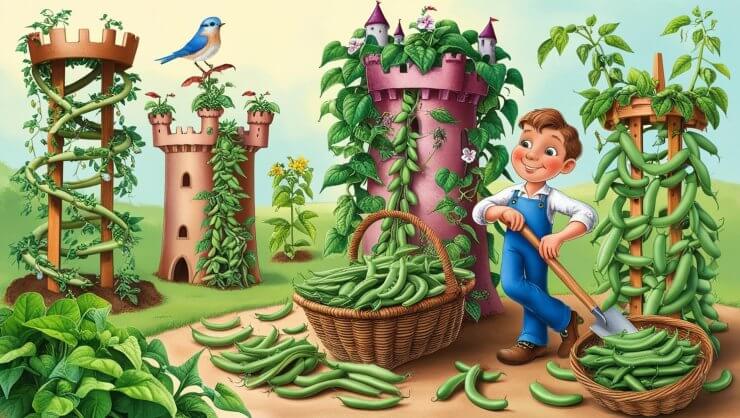Read by Michael Flamel

The sun shone brightly over Jack’s backyard, a far cry from the shadowy legends of the giant beanstalk. Today, Jack was no longer scaling vines into the clouds but was content tending his thriving garden. With a twinkle in his eye, he welcomed visitors to his humble patch of earth.
“Let me set the record straight,” Jack began with a chuckle. “Beans don’t grow into magical skyscrapers. But what they do offer is just as enchanting: nourishment, versatility, and a little garden magic of their own!”
Jack leaned on his spade, gesturing to rows of lush greenery. “Let me tell you about the different types of beans home gardeners like you can grow.”
The Bean Basics, According to Jack
1. Pole Beans
“Pole beans are the climbers. They love to stretch upward, wrapping themselves around trellises, poles, or even a garden fence. These beans need vertical space, so they’re great for raised beds or a corner of your garden with sturdy supports. Examples? Think Blue Lake and Kentucky Wonder. Trust me, they don’t just look pretty—they’re prolific.”
Culinary Tip: Pole beans stay tender when cooked lightly. Try steaming them with a drizzle of olive oil, garlic, and lemon for a garden-fresh side dish.
2. Bush Beans
“These little guys prefer to stay low to the ground,” Jack explained, crouching beside a row of compact plants. “They’re perfect for raised beds or even large containers. Green beans like Contender or wax beans like Gold Rush fall into this category. They’re quick to mature and don’t need much support.”
Culinary Tip: Roast bush beans with a sprinkle of sea salt and Parmesan for a crunchy, savory snack.
3. Runner Beans
“Runner beans are the drama queens of the garden,” Jack said with a laugh. “With their vibrant flowers, they’re perfect for trellises or garden arches. Scarlet Runner is a favorite for its striking red blooms and edible pods. And yes, hummingbirds love them too!”
Culinary Tip: Use runner beans in hearty stews or casseroles. Their slightly firmer texture holds up well in slow-cooked dishes.
4. Dry Beans
“These are the beans you grow for storing, like black beans, kidney beans, or the ever-popular pinto beans,” Jack said, holding up a handful of dried pods. “They need a longer growing season, but they’re worth the wait. Dry beans are best in a sunny garden bed with plenty of room.”
Culinary Tip: Make a classic three-bean chili, blending kidney, black, and pinto beans with smoky spices for a protein-packed meal.
Encouraging Your Bean Dreams
- For Climbers: “To help pole and runner beans climb, give them sturdy trellises or poles. Train the vines by gently wrapping them around the supports as they grow.”
- For Ground-Lovers: “Bush beans and dry beans prefer a cozy spot with well-drained soil. If you’re tight on space, use large containers with good drainage holes.”
- Fun Fact: Jack winked, “Don’t forget that beans actually improve your soil by fixing nitrogen. They’re like little garden superheroes!”
How North American Gardeners Incorporate Beans
- In community gardens, beans are often grown alongside corn and squash, mimicking the Native American “Three Sisters” planting tradition.
- Urban gardeners embrace vertical gardening, using poles and fences to maximize space with pole beans.
- Container gardeners love dwarf bush beans for patios and balconies, proving you don’t need a giant garden for a big harvest.
Jack’s Favorite Bean Recipes
- Fresh Garden Bean Salad: Toss steamed green beans with cherry tomatoes, feta, and balsamic vinaigrette.
- Classic Succotash: Combine lima beans, corn, and bell peppers for a colorful side dish.
- Homemade Baked Beans: Slow-cook navy beans with molasses, bacon, and a touch of mustard for a comforting classic.
Fun Bean Facts
- Did you know? Some bean seeds have been found in archaeological digs dating back over 7,000 years!
- Bean flowers come in a variety of colors, from white to pink to vibrant red, adding beauty to any garden.
- Beans are a staple in many North American gardens because they’re so easy to grow and store.
Helpful Links: For more tips on growing beans, check out the Food Gardening Network’s Green Beans guide. ❖


 Previous
Previous

